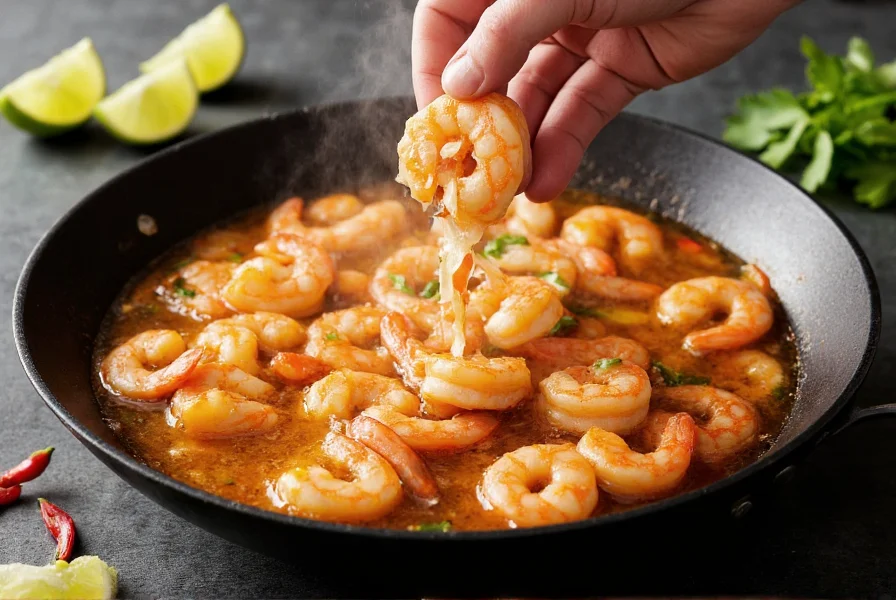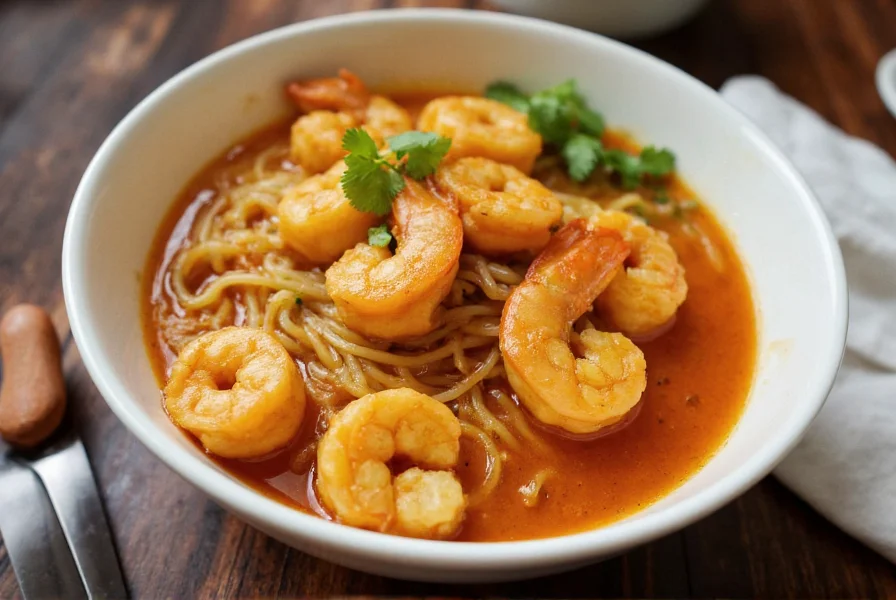If you're searching for an easy lime chili shrimp ramen recipe that delivers authentic flavors without complicated techniques, you've found the right guide. This Southeast Asian fusion dish has gained popularity for its perfect balance of spicy, sour, and savory elements that awaken the palate while remaining approachable for home cooks.
The Essential Components of Authentic Lime Chili Shrimp Ramen
What makes a truly exceptional lime chili shrimp ramen? It's not just about throwing ingredients together—it's understanding how each component contributes to the final harmony of flavors. The magic happens when quality shrimp meets a properly balanced broth with just the right amount of citrus acidity and chili heat.
Unlike basic instant ramen upgrades, authentic lime chili shrimp ramen requires attention to broth development. The foundation starts with a quality stock—homemade or carefully selected store-bought—that gets transformed through strategic additions of fresh aromatics and seasonings.
| Core Ingredient | Function in Dish | Quality Indicators |
|---|---|---|
| Fresh shrimp (21-25 count) | Protein centerpiece with natural sweetness | Firm texture, ocean-fresh scent, no ammonia odor |
| Fresh key limes | Provides bright acidity without harshness | Deep green color, heavy for size, thin skin |
| Chili garlic sauce | Delivers complex heat and umami depth | Visible garlic pieces, balanced spice level |
| Ramen noodles | Texture contrast and starch for broth body | Al dente when cooked, slightly chewy texture |
Step-by-Step Preparation Guide
Mastering lime chili shrimp ramen requires understanding the proper sequence of operations. Many home cooks make the critical error of adding citrus too early, which diminishes its bright flavor profile during cooking.
Broth Development Techniques
The broth makes or breaks your lime chili shrimp ramen experience. Start with 4 cups of quality chicken or vegetable stock heated to a gentle simmer. Add 2 tablespoons of grated ginger and 3 thinly sliced garlic cloves, allowing them to infuse the broth for 5 minutes without boiling vigorously.
Next, incorporate 2-3 tablespoons of chili garlic sauce (adjust to taste) and 1 tablespoon of fish sauce. The fish sauce might seem counterintuitive, but it provides essential umami depth without making the dish taste fishy. Let this mixture simmer for another 3 minutes to allow flavors to meld.

Shrimp Cooking Methodology
Raw shrimp cook extremely quickly—typically 2-3 minutes per side. Overcooking transforms them from tender to rubbery. Add 12 ounces of peeled and deveined shrimp to the simmering broth and cook just until they turn opaque and pink, about 2 minutes.
Immediately remove the shrimp from the broth to prevent carryover cooking. This step is crucial for maintaining the delicate texture that defines excellent lime chili shrimp ramen. Return the shrimp to the broth only after adding the lime juice to finish the dish.
Noodle Preparation Secrets
Cook 2 servings of ramen noodles separately according to package directions, but stop 1 minute before the recommended time. The noodles will continue cooking when added to the hot broth. Drain and rinse under cold water to stop the cooking process and remove excess starch that would cloud your broth.
Final Assembly for Maximum Flavor
This is where most lime chili shrimp ramen recipes fail—adding the citrus too early. The volatile compounds in lime juice break down with prolonged heat exposure, diminishing its bright flavor. Only after removing the broth from heat should you stir in the juice of 2-3 fresh limes.
Return the cooked shrimp to the broth, add the noodles, and gently combine. The residual heat will warm everything through without compromising the delicate lime flavor. This technique preserves the vibrant citrus notes that define authentic lime chili shrimp ramen.
Common Mistakes to Avoid
Even experienced cooks make these critical errors when preparing lime chili shrimp ramen:
- Using bottled lime juice - Freshly squeezed lime juice provides complex flavor notes that bottled versions lack
- Overcooking the shrimp - Shrimp become tough and rubbery after just 30 seconds past doneness
- Adding lime too early - Heat destroys the delicate citrus compounds, resulting in flat flavor
- Using low-quality broth - The broth forms 70% of the flavor profile; don't compromise here
- Skipping the fish sauce - This ingredient provides essential umami without making the dish taste fishy
Variations for Different Dietary Preferences
One reason lime chili shrimp ramen has gained popularity is its adaptability. Here are professional-tested variations that maintain the dish's integrity while accommodating different needs:
Gluten-Free Adaptation
For those seeking a gluten-free lime chili shrimp ramen, substitute traditional ramen noodles with rice noodles or zucchini noodles. When using rice noodles, soak them in hot water rather than boiling to prevent mushiness. Add them directly to the finished broth just before serving.
Vegan Version
Create a plant-based lime chili shrimp ramen by replacing shrimp with king oyster mushrooms cut to resemble shrimp. Marinate the mushrooms in a mixture of nori flakes, soy sauce, and a touch of liquid smoke for 15 minutes before cooking to mimic seafood flavor.

Serving Suggestions for Restaurant-Quality Presentation
Elevate your homemade lime chili shrimp ramen with these professional finishing touches:
- Add thinly sliced red chili peppers for visual appeal and extra heat
- Garnish with fresh cilantro leaves and microgreens
- Float a few lime wedges on the side of the bowl
- Sprinkle with toasted sesame seeds for nutty flavor and texture
- Add a soft-boiled egg for richness (cook separately and add just before serving)
The key to impressive presentation is contrast—vibrant orange broth against white noodles, green herbs against red chili flakes. Serve in pre-warmed bowls to maintain optimal eating temperature throughout the meal.
Storage and Reheating Guidelines
If you have leftovers of your lime chili shrimp ramen (unlikely, but possible), store components separately for best results. Keep the broth, noodles, and shrimp in separate airtight containers in the refrigerator for up to 2 days.
When reheating, warm the broth gently without boiling, then add the noodles and shrimp just until heated through. Never reheat the entire dish together as this overcooks the shrimp and makes noodles mushy. Add a fresh squeeze of lime after reheating to restore brightness.
Frequently Asked Questions
Can I use frozen shrimp for lime chili shrimp ramen?
Yes, you can use frozen shrimp, but proper thawing is essential. Place frozen shrimp in a sealed bag and submerge in cold water for 15-20 minutes. Never cook frozen shrimp directly in the broth as this dilutes the flavor and creates uneven cooking. Pat thawed shrimp completely dry before adding to the broth for optimal texture.
What's the best substitute for fish sauce in lime chili shrimp ramen?
If you don't have fish sauce, the closest substitute is a combination of soy sauce and a small amount of Worcestershire sauce (1:1 ratio). For a vegan alternative, use tamari with a pinch of seaweed flakes. However, authentic lime chili shrimp ramen benefits significantly from fish sauce's unique umami profile, so it's worth purchasing a small bottle specifically for this dish.
How can I adjust the spice level in lime chili shrimp ramen?
Control the heat in your lime chili shrimp ramen by adjusting the chili garlic sauce incrementally. Start with 1 tablespoon and taste the broth before adding more. For immediate heat reduction, add a teaspoon of honey or a splash of coconut milk. Remember that spice perception increases as the dish sits, so it's better to start mild and build heat gradually.
Why does my lime chili shrimp ramen broth taste flat?
Flat-tasting broth usually results from three common issues: adding lime juice too early in cooking, using insufficient fish sauce for umami depth, or not properly balancing the four taste elements (salty, sour, sweet, spicy). Fix flat broth by removing from heat, then adding lime juice incrementally while tasting. A small pinch of sugar can also help balance flavors without making the dish sweet.











 浙公网安备
33010002000092号
浙公网安备
33010002000092号 浙B2-20120091-4
浙B2-20120091-4